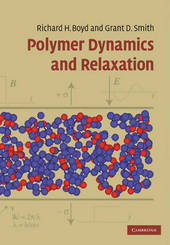
|
Polymer Dynamics and Relaxation
Paperback / softback
Main Details
| Title |
Polymer Dynamics and Relaxation
|
| Authors and Contributors |
By (author) Richard Boyd
|
|
By (author) Grant Smith
|
| Physical Properties |
| Format:Paperback / softback | | Pages:266 | | Dimensions(mm): Height 244,Width 170 |
|
| Category/Genre | Physical chemistry |
|---|
| ISBN/Barcode |
9780521152914
|
| Classifications | Dewey:668.9 |
|---|
| Audience | | Professional & Vocational | |
|---|
| Illustrations |
Worked examples or Exercises
|
|
Publishing Details |
| Publisher |
Cambridge University Press
|
| Imprint |
Cambridge University Press
|
| Publication Date |
5 August 2010 |
| Publication Country |
United Kingdom
|
Description
Polymers exhibit a range of physical characteristics, from rubber-like elasticity to the glassy state. These particular properties are controlled at the molecular level by the mobility of the structural constituents. Remarkable changes in mobility can be witnessed with temperature, over narrow, well defined regions, termed relaxation processes. This is an important, unique phenomenon controlling polymer transition behaviour and is described here at an introductory level. The important types of relaxation processes from amorphous to crystalline polymers and polymeric miscible blends are covered, in conjunction with the broad spectrum of experimental methods used to study them. In-depth discussion of molecular level interpretation, including atomistic level computer simulations and applications to molecular mechanism elucidation, are discussed. The result is a self-contained approach to polymeric interpretation suitable for researchers in materials science, physics and chemistry interested in the relaxation processes of polymeric systems.
ReviewsReview of the hardback: 'The authors have a real gift for conveying the gist of an idea intelligently and effectively ... the book is consistently accessible and clear-headed in a way that can engage many an undergraduate's interest ... warmly recommended. Boyd and Smith have done a good job of explaining the problems and will certainly get you thinking.' Current Engineering Practice
|